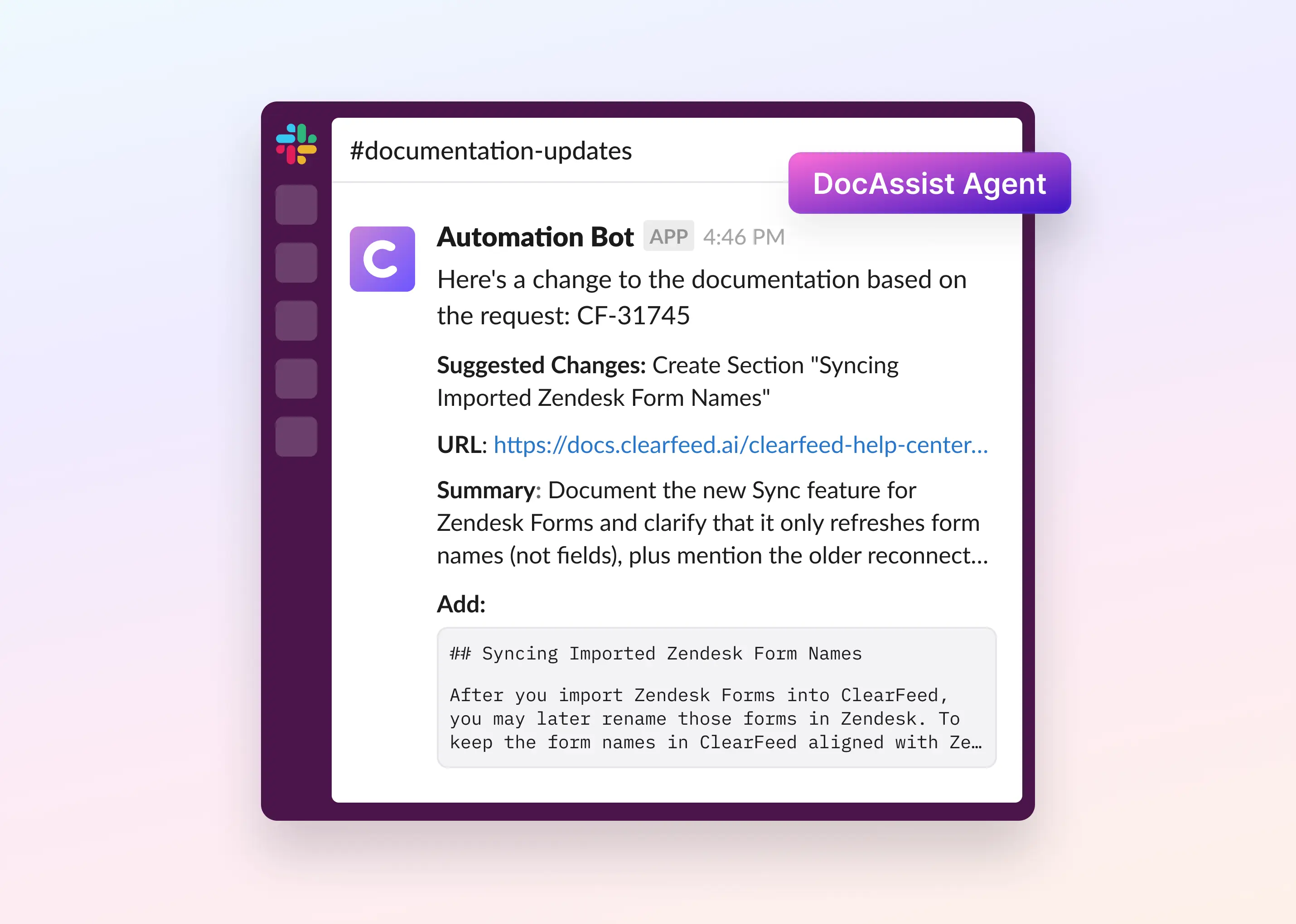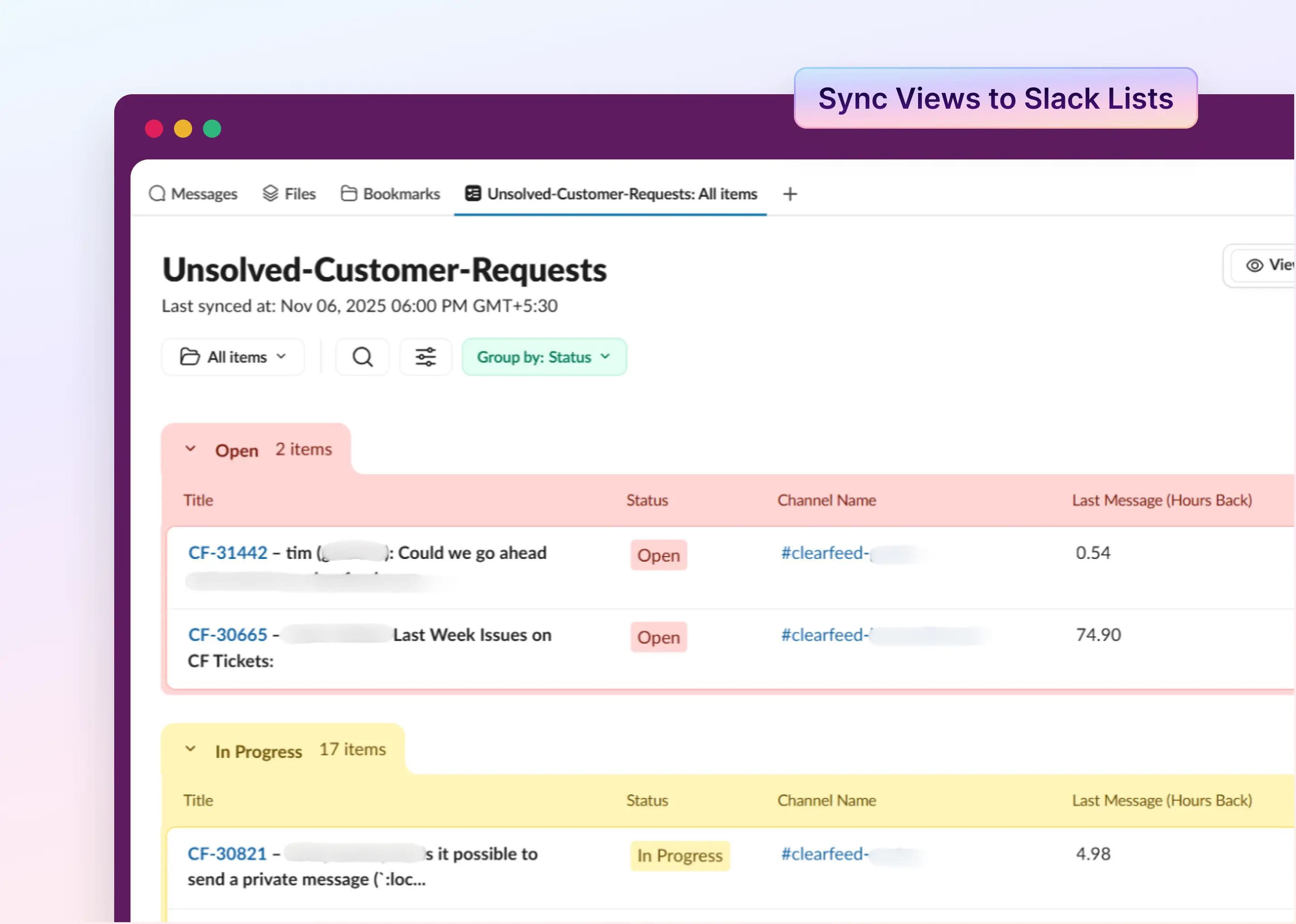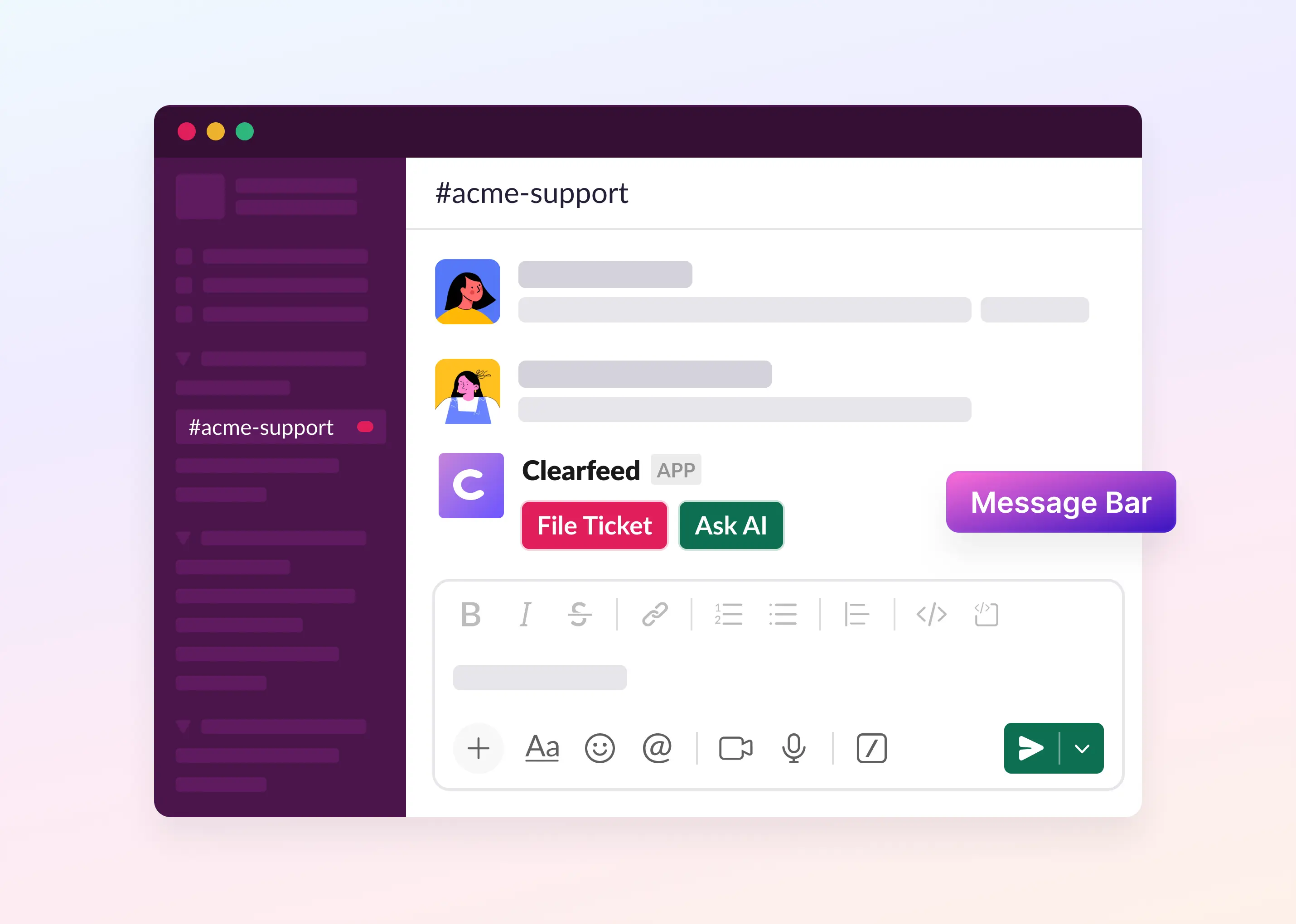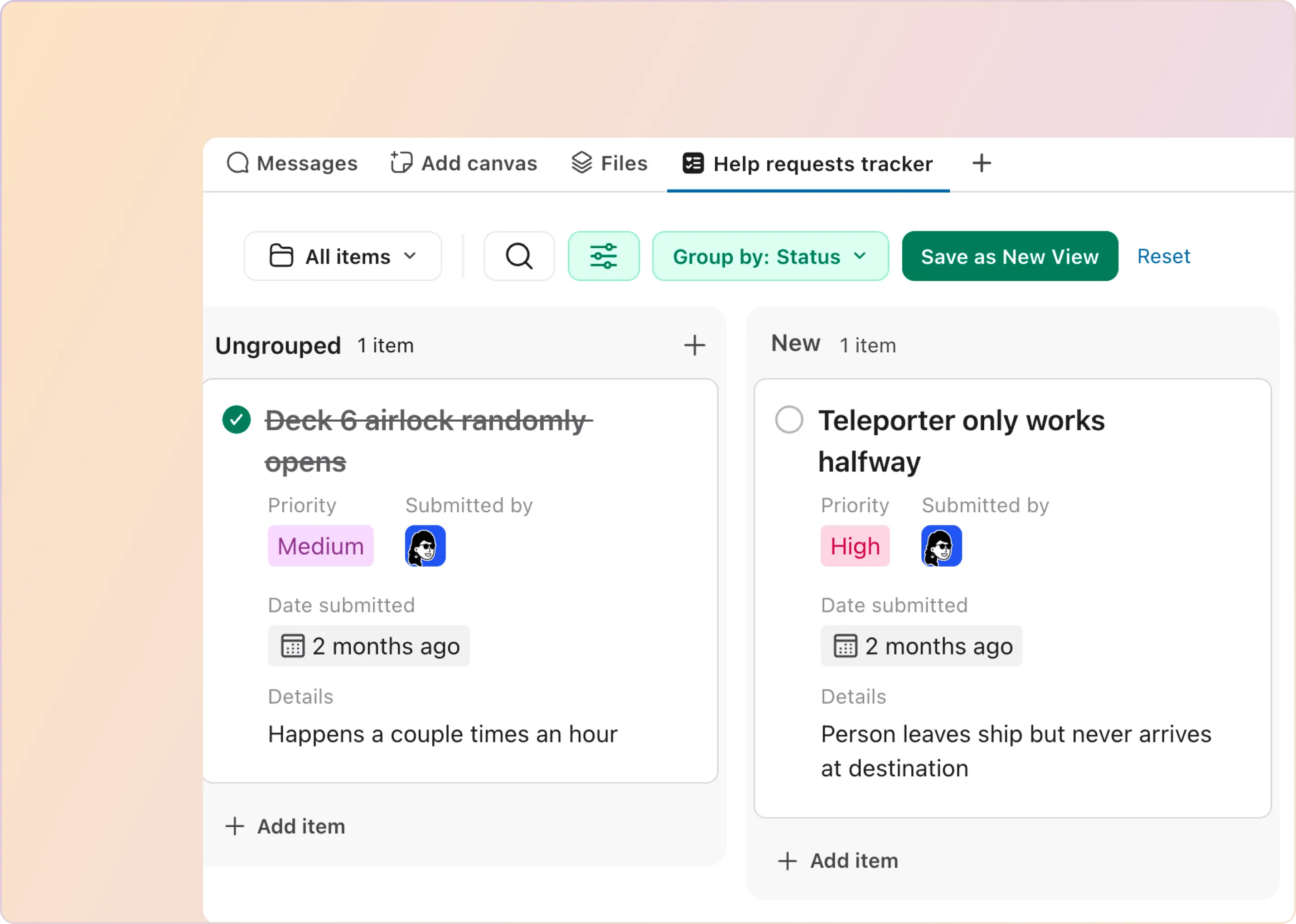Using Slack for support can make your team faster and help your customers. But a good system needs to be simple and powerful. Tracking requests by hand in channels is messy. A proper ticketing system saves time and stops you from missing messages.
I studied what makes a great Slack ticketing tool. Here are the key features:
- Works inside Slack: Create, assign, and close tickets without leaving Slack.
- Smart routing: Sends requests to the right person and tracks urgent issues.
- Connects to other tools: Syncs with systems like Zendesk or Jira.
- Uses automation: AI and automated workflows save time on repetitive tasks.
- Provides clear reports: Shows managers team performance with dashboards.
- Offers good support: The vendor helps you set up quickly and is there if you need help.
Now, let's look at the best Slack ticketing systems for 2025.
7 Best Slack Ticketing Systems for Support Teams
Here is our list of the best Slack ticketing systems based on their distinctive features, pros and cons, and pricing:
- ClearFeed
- Zendesk for Slack
- Freshdesk for Slack
- Jira Service Management + Slack
- Salesforce Service Cloud
- HubSpot Service Hub
- Linear Asks
1. ClearFeed
ClearFeed is a helpdesk system that works inside Slack. It is made for teams who use Slack for support. It turns Slack messages into tracked tickets. Your team never needs to switch to another app. It also connects Slack to your other tools like Zendesk or Jira. It shares updates between them. This keeps everyone on the same page.
Best for:
ClearFeed is best for teams that handle requests in Slack. It is made for:
- Support teams helping customers in Slack.
- IT helpdesks fixing internal employee issues.
- Engineering teams tracking bugs and sending them to Jira.
- HR and Operations managing internal requests.
If your team uses many Slack threads and loses track of them, ClearFeed can help.
Main Features:
- Full ticket lifecycle in Slack: Create, assign, comment, and resolve tickets directly from Slack. Every update syncs automatically with your helpdesk tools, keeping systems and teams aligned.
- AI Agents for faster support: ClearFeed’s Virtual Agent auto-responds to routine queries, while the Agent Assistant helps human agents by suggesting replies, fetching context, and summarizing long threads — cutting response times dramatically.
- Smart triage, SLAs, and escalations: Auto-categorize requests, prioritize by urgency or customer type, and set SLA timers with reminders before breaches.
- Multi-channel request intake: Combine Slack, email, and web form requests into a single unified queue so no issue is lost across channels.
- Actionable reports and insights: Track response times, SLA compliance, and ticket volume trends — all accessible from Slack or external dashboards.
- Secure and scalable: Enterprise-grade access control, SSO, and robust performance even across multiple Slack workspaces or customer Connect channels.
Pricing:
The Starter plan costs $24 per person each month. It includes ticketing in Slack, automations, and basic AI. The Professional plan costs $49 per person each month. It adds advanced workflows, better SLA tracking, and a customer portal. Enterprise plans and more AI features are available for larger teams.
ClearFeed works inside Slack. It does not make your team use a separate tool. It organizes your chats, reduces noise, and automatically sorts requests. This helps your team handle more work without scaling chaos. Try it for free for 14 days and see how it can help streamline your support workflow in Slack.
2. Zendesk Support
Zendesk is one of the most widely used customer service and support platforms. It helps businesses manage customer requests, track issues, and provide multi-channel support from a single system.
Best for:
Zendesk’s native Slack integration is best for teams that want to connect Slack with a full-featured helpdesk. It is made for:
- Customer Support Teams managing large volumes of tickets across email, chat, and Slack.
- IT & HR Teams letting employees raise and track issues directly from Slack.
- Cross-functional Teams (support, product, engineering) needing visibility on ticket updates in Slack.
If your team already uses Zendesk and wants to reduce context-switching while keeping Slack in the loop, the native integration is a strong fit.
Main Features:
- You can get ticket alerts in any Slack channel. You choose which updates to see.
- Create new Zendesk tickets directly from a Slack message.
- Use Slack threads to have private discussions about a ticket.
- An AI bot can suggest help articles from your knowledge base inside Slack.
- Connect several Zendesk accounts to multiple Slack workspaces.
Pricing:
Starts at $19 per agent/month for basic support features. The Suite plans begin at $55 per agent/month, adding omnichannel ticketing, SLAs, analytics, and automation. Enterprise tiers offer advanced customization, roles, and security controls.
3. Freshdesk
Freshdesk is an online tool for customer support. It helps companies manage all customer questions from one place. It works for email, chat, phone, and social media messages.
Best for:
- Small to mid-sized businesses that want a simple, affordable helpdesk.
- Teams handling multi-channel support (email, chat, phone, social).
- Companies that don’t rely heavily on Slack for internal workflows (though integrations exist).
Main Features:
- Get instant alerts in Slack for any ticket change.
- Create a new Freshdesk ticket from any Slack message.
- Update ticket details and add notes directly from Slack.
- Discuss tickets in private Slack threads that sync with Freshdesk.
- Send ticket alerts to specific channels based on the team.
- Use rules to auto-assign or escalate tickets.
- Message agents directly with personal ticket updates.
- See all agent comments synced between Slack and Freshdesk.
- Agents can view their own ticket list inside Slack.
- Share knowledge base articles easily in conversations.
Pricing:
Starts at $15 per agent/month for the Growth plan with basic ticketing, automation, and reporting. The Pro plan ($49/agent/month) adds advanced SLAs, custom roles, and multilingual support. Enterprise tiers ($79/agent/month) include sandboxing, skill-based routing, and advanced security controls.
4. Jira Service Management
JSM centralizes internal and external requests into a single queue, automates ticket routing, and connects seamlessly with Jira Software for engineering collaboration. It’s used for IT support, DevOps, and customer service, offering advanced workflows, SLAs, and change management tools.
Best for:
Jira Service Management is best suited for:
- IT and Operations teams that manage internal employee requests, incidents, and approvals within structured workflows.
- Engineering and DevOps teams that need tight integration between support tickets, bugs, and deployments in Jira Software. ility, and automation across multiple departments.
- Organizations already using Atlassian tools (like Jira, Confluence, or Bitbucket) and want a unified ecosystem for support, development, and change management.
Main Features:
- Create new Jira Service Management tickets from any Slack message.
- Get instant alerts in Slack for ticket updates, comments, and status changes.
- Manage incidents and approvals directly from Slack.
- Collaborate on tickets in dedicated Slack channels or threads.
- Auto-route issues and send priority alerts to the right Slack channels.
- Approve or reject change requests without leaving Slack.
- Sync all actions between Slack and Jira Service Management in real time.
Pricing:
Freshdesk has a free plan for up to 3 agents. It includes basic ticketing. The Standard plan costs about $22 per agent each month. It adds features like custom queues and SLA tracking. The Premium plan costs about $49 per agent each month. It adds advanced automation, asset management, and 24/7 support. Large organizations can get a custom Enterprise plan.
5. Salesforce Service Cloud
Salesforce Service Cloud is a tool for customer support. It is part of the Salesforce system. It lets companies handle all customer questions from one screen. This includes email, chat, phone, social media, and help websites.
Best for:
- Mid-sized to enterprise businesses that already use Salesforce CRM.
- Customer service and success teams handling high volumes of multi-channel requests.
- Organizations needing deep customization, analytics, and automation for complex support operations.
Main Features:
- Create Salesforce cases directly from Slack messages or threads with one click
- Get instant alerts in Slack when case status, comments, or fields change
- Update case fields (e.g. priority, owner, status) or add internal notes from Slack
- Post public comments or replies in Slack that sync back to Service Cloud
- Route notifications to specific Slack channels (e.g. high priority, VIP clients)
- Use rules to auto-assign, escalate, or notify based on case attributes
- Approve workflows or requests (if built in Salesforce) directly from Slack
- Real-time bi-directional sync: Slack and Service Cloud stay in sync with updates
- Private Slack threads or triage channels for internal discussion without exposing customer view
Pricing:
Starts at $25 per user/month for the Starter Suite with basic case management, help center, and Slack integration. The Enterprise tier ($175/user/month) adds AI, workflow automation, and advanced support. Higher tiers like Unlimited ($350/user/month) and Agentforce 1 Service ($550/user/month) deliver features like full AI, sandbox, and unmetered agenting.
6. HubSpot Service Hub
HubSpot Service Hub is a helpdesk tool. It is part of the HubSpot system. It helps support teams manage tickets and automate tasks. It also connects customer data to your sales and marketing teams.
Best for:
- Small to mid-sized businesses using HubSpot CRM or looking for an all-in-one customer platform.
- Support and success teams that want shared visibility with sales and marketing.
- Companies focused on customer retention and proactive service.
Main Features:
- Create new HubSpot tickets directly from any Slack message.
- Search and view HubSpot contacts, deals, and tickets using simple slash commands.
- Get instant Slack alerts when tickets are created, updated, or assigned.
- Add comments or update ticket status from Slack, synced automatically to HubSpot.
- Receive customer chat notifications and reply to messages right from Slack.
- Send automated Slack alerts from HubSpot workflows to channels or teammates.
- Keep all HubSpot and Slack conversations in sync in real time.
Pricing:
Starts at $15 per seat/month for the Service Hub Starter, which includes ticket pipelines, routing, and canned snippets. The Professional plan ($100/seat/month) adds a help desk workspace, knowledge base, customer portal, and success tools. The Enterprise plan ($150/seat/month) includes advanced routing, custom objects, and enterprise-grade controls.
7. Linear Asks
Linear is a tool for software teams to track their work. It helps teams plan and build products quickly. It has a clean design and uses keyboard shortcuts. Linear connects with tools like Slack and GitHub. Its "Linear Asks" feature turns Slack messages into tasks.
Best for:
- Product and engineering teams that want a fast, intuitive alternative to Jira.
- Startups and tech companies managing sprints, roadmaps, and bug tracking.
- Teams using Slack who want to instantly convert requests or feedback into Linear issues.
Main Features:
- You can submit requests from Slack or email. They are automatically sent to the right team in Linear.
- Anyone in Slack can submit a request without a Linear account.
- Create custom forms in Slack to collect all the needed information.
- Turn any Slack message into a request with an emoji reaction.
- All comments and updates stay in sync between Slack and Linear.
- Handle private requests securely with special access controls.
- Automatically create requests from specific messages or emojis.
- Use a shared team inbox to manage requests without leaving Slack.
- Connect requests to customer data, set deadlines, and use automation.
- Use it for bug reports, IT help, customer issues, and private HR tickets.
Pricing:
The Business plan ($14 per user/month) includes Linear Asks, allowing teams to capture and manage requests directly from Slack. The Enterprise plan (custom pricing) extends this with advanced Linear Asks features, dashboards, and enhanced security options like SAML SSO and SCIM.
Pick the Slack Ticketing System That’s Right for You
Slack is now your team's main workspace. A good ticketing system keeps it organized and running smoothly. Every team needs a different tool. A small startup needs speed. A large company needs to handle complex work.
Choose a tool that fits how your team works. Think about your biggest problems. Then pick the tool that fixes them. The right system removes delays. This gives your team more time for important work.
Frequently Asked Questions
What Are the Most Cost-Effective Slack-Based Helpdesk Solutions?
The most cost-effective Slack-based helpdesk solution is ClearFeed. It integrates directly into Slack, allowing teams to manage support requests without paying for standalone platforms. Small teams benefit from built-in features, while larger organizations can combine them with enterprise systems like Zendesk.
How Do I Evaluate Helpdesk Platforms Built Natively for Slack?
Evaluate Slack-native helpdesk platforms by checking message-to-ticket conversion, SLA automations, integrations (like Zendesk or Jira), in-Slack reporting, and user experience. Strong platforms allow full support workflows to stay inside Slack, reducing context-switching and improving team response times.
How Do I Choose Between Zendesk vs Native Slack Helpdesks?
The main difference between Zendesk and native Slack helpdesks is their focus. Choose Zendesk for customer-facing, multi-channel support with features like a knowledge base and CSAT. Choose native Slack helpdesks for internal, Slack-first teams needing fast response, automation, and in-Slack workflows.
How Do Slack-Native Helpdesks Compare to Email-Based Systems?
The main difference between Slack-native helpdesks and email-based systems is speed and visibility. Slack-native tools enable real-time collaboration, instant updates, and thread-based resolution. Email-based systems often cause delays, create silos, and lack transparency, making them less efficient for internal support workflows.
Why Choose Slack Ticketing Over Traditional Helpdesk Software?
Choose Slack ticketing over traditional helpdesk software to reduce context switching, speed up response times, and keep communication centralized. Slack-based workflows happen where teams already collaborate, while traditional helpdesks require toggling between inboxes, dashboards, and tools—slowing down efficiency and adoption.
















